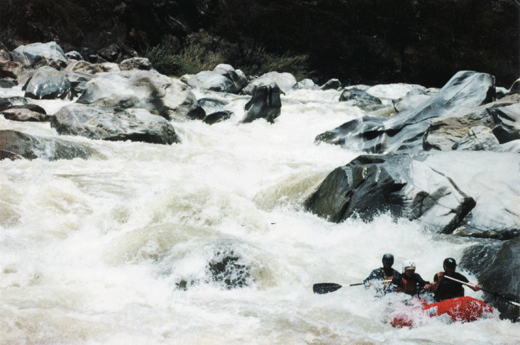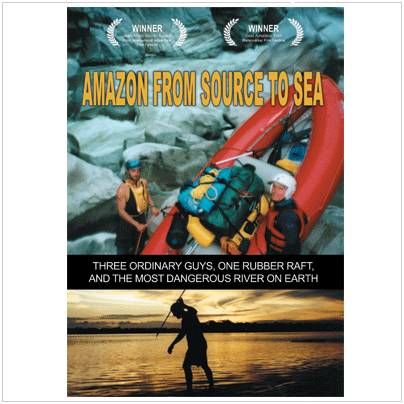The Amazon River begins as a maelstrom of whitewater high up in the Andes Mountains. From eighteen thousand feet, it cascades down to the Amazon Basin below through deep fractured canyons. It wasn’t until 1986 when the first team, led by Piotr Chmielinski, was successful in voyaging the Amazon’s full length. The Amazon’s upper tributaries contain some of the word’s most dangerous whitewater. Before Chmielinski’s success, three teams had attempted to run the world’s greatest river but failed due to deaths in the whitewater.
In 1999 a multi-national team set out to run the full length of the Amazon River once again. Colin Angus of Canada, Ben Kozel, Australian, and Scott Borthwick, South African began their attempt in September. As well as their goal of voyaging the world’s largest river, the trio also wanted to cross South America from one side to the other under their own power. Since the 6,600-km length of the Amazon almost spans the South American continent, they decided to hike the four hundred-km from the Pacific Coast to the South American Continental Divide and the source of the Amazon. From here they would follow the river all the way to the Atlantic.
Ironically, the Western Andes is one of the driest areas on the planet and is composed of huge expanses of desert. Ten days after bidding goodbye to the Pacific Ocean, the expeditioners found themselves hopelessly lost in a desert and running out of water. The situation became so desperate that they were forced to drop their backpacks, continuing in a state of complete dehydration. Fortunately they stumbled on until they found the promised oasis. From here, they resumed their trek on towards the legendary source of the Amazon.
Two weeks after starting, the continental divide was reached and the first trickles were located on the slopes of Mt. Quehuishua. At eighteen thousand feet, it was a world of rock, ice, snow and jagged mountain peaks. It seemed like a fitting setting for the birthplace of the world’s largest and most mystical river. From here, there was only 6,600 km to go.
The droplets of the Amazon were followed by foot for several days until the volume increased enough to float their whitewater raft. From here, the wild roller coaster ride would begin. The canyons were so steep and deep (much bigger than the Grand Canyon), that there was no way to depart from the river other than continuing through the rapids. Scouting and portaging the most dangerous parts of the whitewater was impossible due to the sheer cliffs coming down to the water’s edge.
It took over a month to navigate the whitewater. Without being able to re-supply, food had to be rationed strictly and any wild foods found would also be utilized. The raft capsized repeatedly in the whitewater and the team were battered and exhausted when they finally emerged into the lush jungle below.
Thinking the most dangerous leg of the journey was over; the gunfire was a nasty surprise for the exhausted adventurers. The Sendero Lumineso, a left wing terrorist group in Peru, were lurking in the remote region of the jungle in the Ene Valley. When the rafting team refused to stop after a ragged group of men called them in from the shore, a man lowered his gun and fired towards the raft. Probably the most terrifying moment of the trip, the team was lucky to escape unscathed.
After passing through the terrorist zone, the raft was converted using balsa logs, bamboo and vines to make it a bit more comfortable. There would be no more rapids, but for the next 6000-km they would have a whole lot of paddling to do. They switched to rowing instead of paddling by lashing the paddles to bamboo. That way one person could propel the boat whilst the others did the daily chores such as cooking and cleaning. In order to lessen the danger posed by the crocodiles, malarial mosquitoes, spiders and snakes on the shore, the men voyaged 24 hours a day on the boat – each taking turns at the oars. At night, on the inflatable cruise ship, the men would drape their aching bodies over the logs and fall asleep. Near the end of the journey, the persistent rain would make life quite miserable.
Five months after beginning at the Pacific, Ben, Colin and Scott triumphantly arrived at the Atlantic Ocean.





